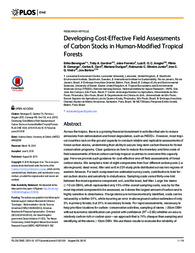Developing cost-effective field assessments of carbon stocks in human-modified tropical forests.
Developing cost-effective field assessments of carbon stocks in human-modified tropical forests.
Autoria: BERENGUER, E.; GARDNER, T. A.; FERREIRA, J.; ARAGÃO, L. E. O. C.; CAMARGO, P. B.; CERRI, C. E.; DURIGAN, M.; OLIVEIRA JUNIOR, R. C.; VIEIRA, I. C. G.; BARLOW, J.
Resumo: Across the tropics, there is a growing financial investment in activities that aim to reduce emissions from deforestation and forest degradation, such as REDD+. However, most tropical countries lack on-the-ground capacity to conduct reliable and replicable assessments of forest carbon stocks, undermining their ability to secure long-term carbon finance for forest conservation programs. Clear guidance on how to reduce the monetary and time costs of field assessments of forest carbon can help tropical countries to overcome this capacity gap. Here we provide such guidance for cost-effective one-off field assessments of forest carbon stocks. We sampled a total of eight components from four different carbon pools (i.e. aboveground, dead wood, litter and soil) in 224 study plots distributed across two regions of eastern Amazon. For each component we estimated survey costs, contribution to total forest carbon stocks and sensitivity to disturbance. Sampling costs varied thirty-one-fold between the most expensive component, soil, and the least, leaf litter. Large live stems (10 cm DBH), which represented only 15% of the overall sampling costs, was by far the most important component to be assessed, as it stores the largest amount of carbon and is highly sensitive to disturbance. If large stems are not taxonomically identified, costs can be reduced by a further 51%, while incurring an error in aboveground carbon estimates of only 5% in primary forests, but 31% in secondary forests. For rapid assessments, necessary to help prioritize locations for carbon- conservation activities, sampling of stems 20cm DBH without taxonomic identification can predict with confidence (R 2 = 0.85) whether an area is relatively carbon-rich or carbon-poor ? an approach that is 74% cheaper than sampling and identifying all the stems 10cm DBH. We use these results to evaluate the reliability of forest carbon stock estimates provided by the IPCC and FAO when applied to human-modified forests, and to highlight areas where cost savings in carbon stock assessments could be most easily made.
Ano de publicação: 2015
Tipo de publicação: Artigo de periódico
Unidade: Embrapa Amazônia Oriental
Palavras-chave: Estoque de carbono, Floresta Tropical
Observações
1 - Por padrão são exibidas publicações dos últimos 20 anos. Para encontrar publicações mais antigas, configure o filtro ano de publicação, colocando o ano a partir do qual você deseja encontrar publicações. O filtro está na coluna da esquerda na busca acima.
2 - Para ler algumas publicações da Embrapa (apenas as que estão em formato ePub), é necessário ter, no celular ou computador, um desses softwares gratuitos. Sistemas Android: Google Play Livros; IOS: iBooks; Windows e Linux: software Calibre.
Acesse outras publicações
Acesse a Base de Dados da Pesquisa Agropecuária (BDPA) para consultar o acervo completo das bibliotecas da Embrapa.

